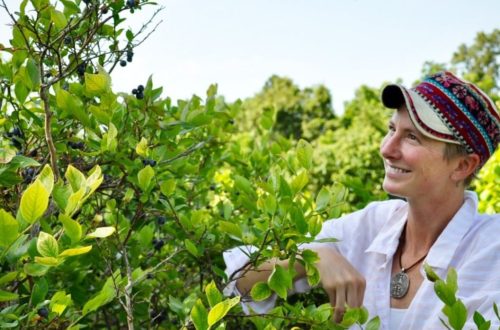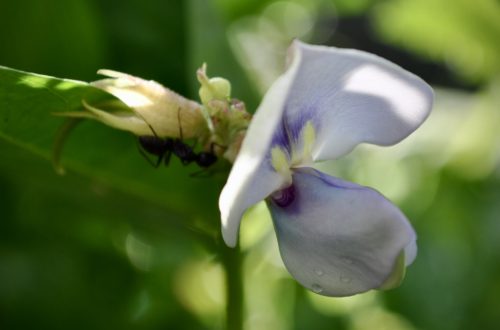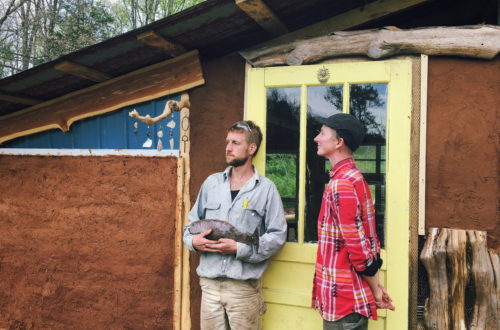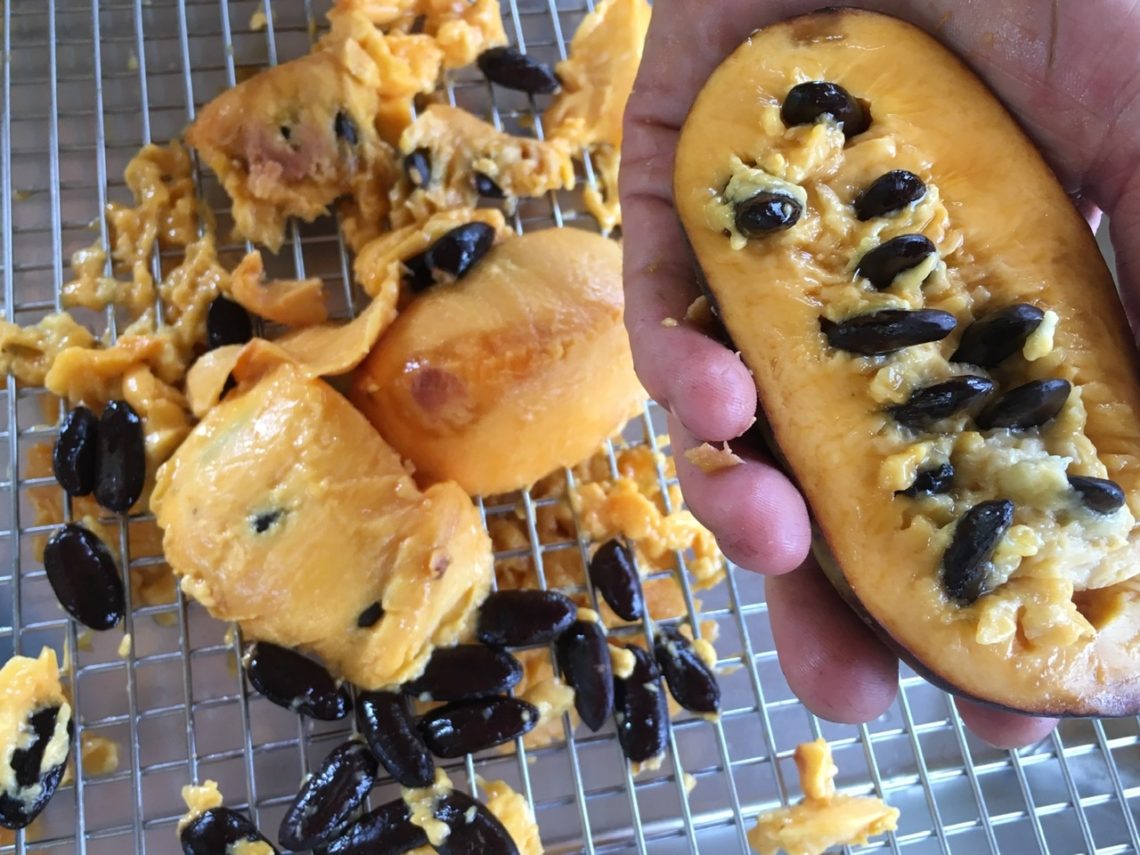
Growing Pawpaws from Seed
Establishing fruit producing trees can often be an intensive and expensive process, but it needn’t be.
Growing out fruit trees from seed is an exciting proposition. Doing so can allow for very low cost tree establishment, broadening of the gene pool (exploring new varieties, building disease resistance etc.) and affords the opportunity to avoid transplant shock. It can also be a low input affair.
Pawpaws are just one of many fruit trees worth growing from seed.

Pawpaws naturally multiply in two ways: sexually (through fruit and subsequent seed production) and asexually (by suckering from roots of established trees.) Commonly seen as dozens or hundreds of trees, pawpaw patches are often clones of one or more individual trees. The trees sucker readily and can grow into dense thickets. Each root sucker is a clone of the mother and thus genetically identical. For fruit production purposes this is less than ideal because 2 or more individuals are needed for proper pollination and fruit set.
On the other hand, sexually multiplied pawpaws create a wider gene pool. The traits from the two parent trees create a distinctly new individual. Pawpaws are considered true to heredity meaning the trees (and fruits thereof) are fairly similar to their parents. This is unlike other fruits, apples for example, that offer a more widely varied lineage. A seed from an Arkansas Black apple may bear fruit that is outrageously different from its parent, but a seed from a Sunflower pawpaw will produce a tree with similar qualities.

Many of the pawpaw varieties available today are selections of superior trees found in the wild. There is evidence to suggest that even these wild trees were selections made by indigenous populations. Over generations the best fruits were favored and replanted. Intentional breeding has been ongoing for several decades, but more is yet to be discovered in the realm of pawpaws.
This has created an array of very high quality fruit that are much bigger, tastier and fleshier than their wild relatives.
The variety of shapes, sizes, colors, flavors and textures of this unique and delightful fruit is astounding. Growing out fruit from seed is one way to explore pawpaw diversity.
When growing out from seed, fruit quality can be expected to be similar to that of the fruit from which it came. A Susquehanna fruit will yield seeds with a high quality fruit, although not identical to its parent. Choosing seeds from selected cultivars means you can grow high quality fruit without the fuss of grafting and increase genetic diversity. For pollination purposes it can be helpful to have a wider variety of individuals too.
We have trees from select pawpaw varieties in our shop, be sure to check them out!

I have spied many pawpaws on ridges and other seemingly unlikely areas thanks to wild animals’ penchants for this delicious fruit. I have even seen pawpaw seeds on a limb 15 feet up an oak tree. Maybe not ideal growth conditions, but it proves the seed’s mobility. In eating the whole fruit, moving around and dropping seed laden scat, raccoons, opossums, coyotes and others are helping propagate pawpaws.
Bottom line is that pawpaws like to grow! Below are a few tips for growing them from seed.
Seed Care
There are two main guidelines for successful germination:
- Don’t let the seeds dry out and
- Don’t let them freeze.
If too much moisture is lost, the dormant embryo within the seeds will suffer and may die. Upon eating or processing the fruit, we clean extra pulp off the seeds and pack them into containers with moist sawdust or sand at 1:1 ratio. If they are from an extra rotten fruit I’ll give them a bath in hydrogen peroxide to sterilize seeds. The goal is to keep them constantly moist from harvest time until germination the following spring. Many folks will pack seeds into plastic bags and store in the refrigerator. We bury buckets filled with seed and sawdust mixture and mulch heavily. Sand is another option.
I’m not sure about the freezing aspect, as the pawpaws’ natural range includes areas that certainly get very cold and frozen. I suspect rotten fruit, duff and other forest debris insulate seeds in the wild from freezing hard. Last year I packed wild seeds in moist sawdust and overwintered them in an unheated high tunnel and got around a 90% germination rate. They definitely got much colder than freezing but did just fine.
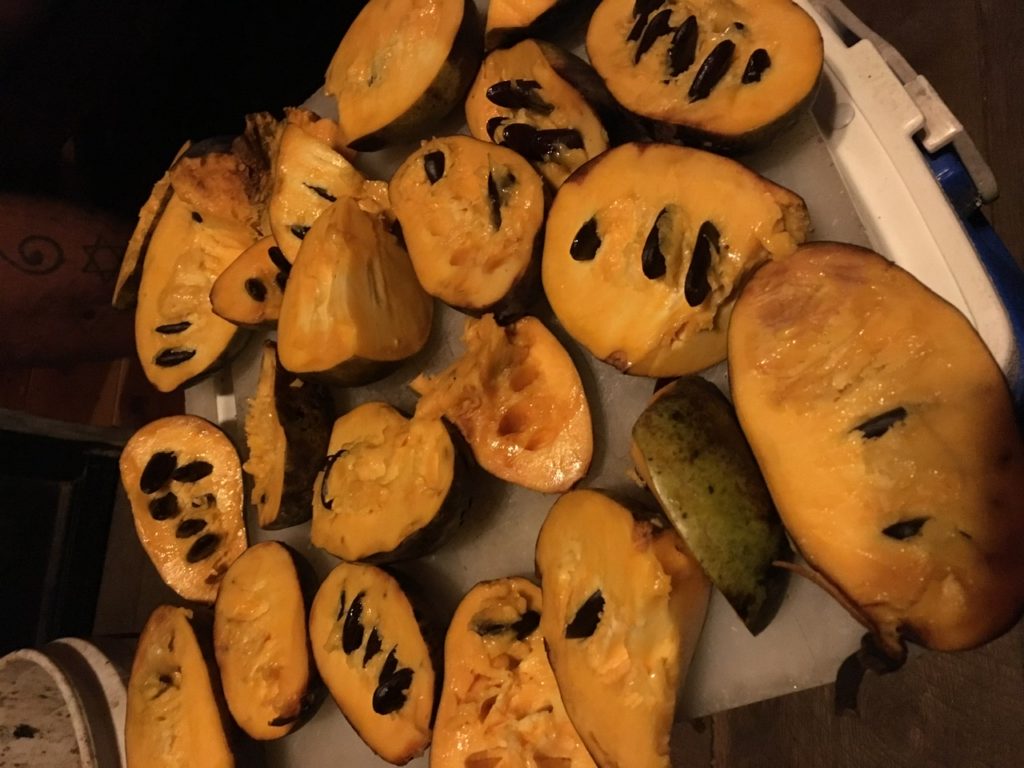
Pawpaws need 70-100 chill days for proper stratification to prepare them for germination. This happens in their natural habitat over winter and we can mimic this by either storing them in a fridge or keeping them stored underground until ready to plant. Of course the simplest option is planting them right away. If you do store them in a plastic bag in the fridge, avoid over saturating the seeds by poking a few pinholes to vent excess moisture.
Check for mold and rinse and/or soak in peroxide. Storing for more than 100 days is of course the norm as fruits harvested in autumn won’t germinate until the following spring without special conditions.
Germination
Being a relative of the many tropical fruits in the Annonacea family, they love heat. Their ideal germination range is 75-85 F (24-29C) and they will germinate just fine on their own when spring or summer temperatures begin to heat up. They will do so much faster if given a boost. If you can manage to keep seeds at 85 F they will break the seed coat and push roots in weeks instead of months. This can get you a couple more months of growth. A heating pad or reptile strip connected to a thermostat below a metal baking pan will work. Just remember to maintain moisture.
Pawpaws are known as hypogeal meaning they develop a root before the leaves. This means you won’t see much above ground activity for quite sometime after germination begins. It may be well into summer before you see the leaves unfold. This means there’s no need for direct light for some time, so you can reduce water loss by placing away from direct light. Be patient.
Given moisture and time pawpaws will grow.
Seeding
Seeding can be done in fall directly from the fruit or after stratification. Seeds should be placed with their flat side down an inch below the surface. Sand or organic mulch can help insulate and retain moisture. Once seeded, maintain constant moisture and keep warm if possible. Pawpaws are cold tolerant, but will respond well to gentle heat during these early days of life.
You can choose to direct seed (as raccoons and others critters do) or grow in containers as only humans can. There’s a trade off here. Directly seeded trees may need periodic or constant irrigation depending on site conditions, but will suffer no transplanting setback. The high inputs for containers and medium mean you can adjust the climate they grow in (for example a shaded high tunnel), move them easily and extend the planting window, but this method also entails that you manage these resources.
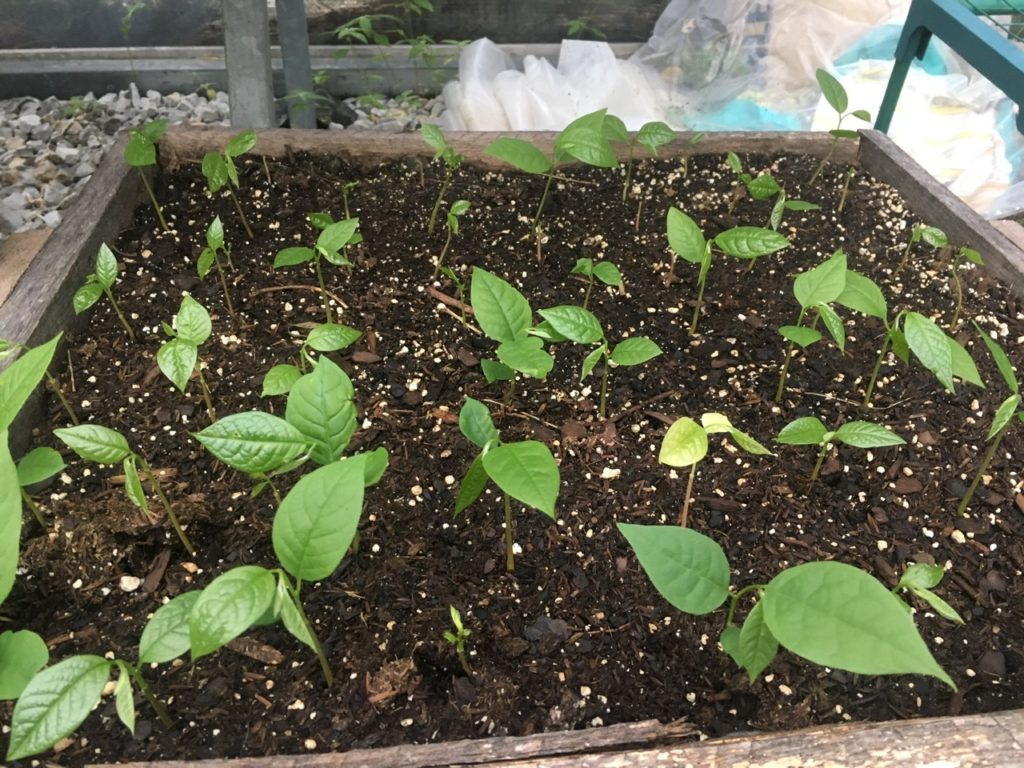
In our nursery and forest garden we employ both methods. Some of the patches I seeded I never watered and yet still got 5” of growth. Not great, but for zero tending I’m happy with that return. In either case until seedlings are at least 2 years old they will be unhappy with full sun and may burn. 30-50% shade is recommended. If you direct seed in near full sun, you will have to arrange some type of shading. Tree tube, window screens on tomatoes cages and other creative ways have been devised.
Their long fragile taproot makes pawpaws vulnerable to damage during transplanting. If you plan to grown them in containers, special considerations are needed. The growth of pawpaws is slow, and they may be in the container for up to 3 years (especially if grafting), so choose wisely. The deeper the pot the better. Ideally it would have an open bottom. Open bottomed containers will facilitate air pruning. When the roots reach the bottom of the container, they stop growing down and the gentle pruning of roots exposed to air encourages fibrous lateral rootlets to develop and creates a more resilient root structure. More bulk and less depth. When planting out into final location, this can make a big difference in how it handles being transplanted. Pawpaw roots are fragile and have a habit of snapping when being moved which can set growth back considerably . Pawpaw seedlings coming up in an air pruning bed.
Pawpaw seedlings coming up in an air pruning bed.
Commonly used pots are known as tree tubes and are often 10” or more in depth but usually quite narrow at 4” or so. This year I seeded pawpaws in 12” deep air pruning boxes with hardware cloth on the bottom. I seeded them 4 inches apart and realized up to 13” of growth this season, some approaching pencil thickness. I grew them in a high tunnel with 50% shade and watered about weekly. We will experiment further with air pruning boxes and beds as this approach shows great promise.
There’s little more to it than this. Keep the seeds moist, don’t let them freeze and plant them an inch deep. Most of all have fun growing pawpaws.



